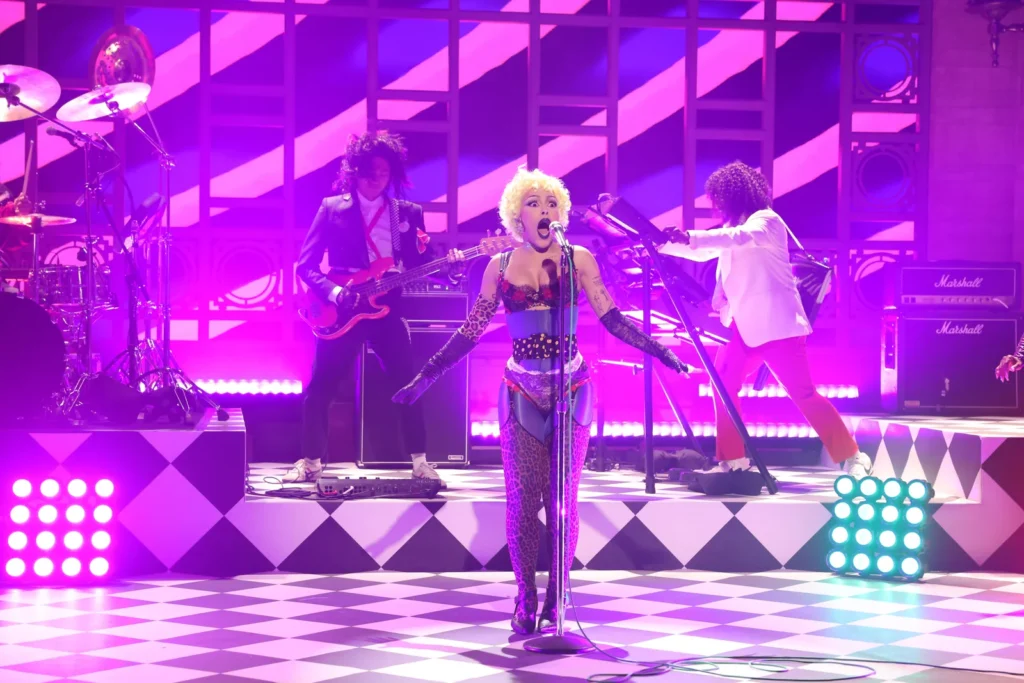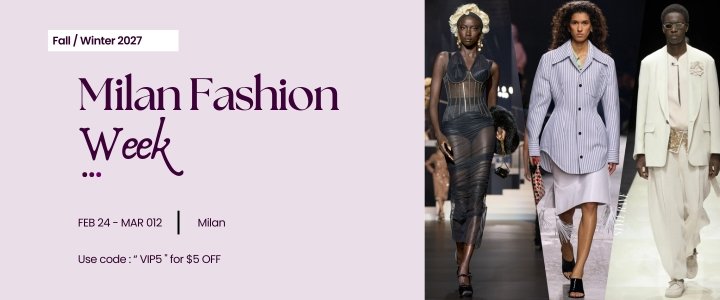When a friend texted me a photo at 1:47 AM last Sunday—just a blurry screenshot of someone in what appeared to be a white lace architectural sculpture walking through a lobby—my response was immediate: “That’s Doja.” No face visible, no caption needed. In an era when most celebrities cycle through stylist-pulled looks with the strategic enthusiasm of a corporate LinkedIn update, Doja Cat has achieved something far more valuable than virality: recognizability through pure aesthetic vision. Her Saturday Night Live appearance wasn’t just a promotional stop for her new album Vie—it was a masterclass in what happens when an artist treats every public moment as part of a larger visual thesis. From the Quine Li entrance look with lapels defying physics to The Blonds showgirl fantasy finale, each piece communicated a singular artistic vision rooted in 1980s excess, reimagined through a contemporary avant-garde lens. This isn’t random. This is authorship.
The concept of the “visual era” in popular music has become as critical to an album’s success as the music itself. What began as Madonna’s cone bra and evolved through Lady Gaga’s meat dress has matured into something far more sophisticated: a holistic approach to image-making where every appearance, every performance, every photographed moment contributes to a cohesive narrative. Doja Cat’s Vie era represents the apex of this evolution, a case study in how meticulous visual curation can transform a musical project into a complete artistic statement.
Strategic Fashion as Declaration
Working with stylist Brett Alan Nelson, Doja Cat constructed her SNL appearance as a series of deliberate fashion moments, each building upon the last to create a comprehensive visual language. The evening opened with that now-infamous Quine Li piece—a white avant-garde lace creation with theatrical overhead lapels that seemed to defy the laws of both physics and good sense. It was absurd, spectacular, and utterly intentional. This wasn’t fashion as decoration; this was fashion as declaration.
The choice to lead with such an aggressively avant-garde piece signals a crucial shift in how contemporary artists approach visibility. Where previous generations might have saved their most experimental looks for controlled environments like music videos or album covers, Doja Cat deployed hers in the chaotic, unpredictable setting of live television. The message was clear: this is not a costume for performance. This is who I am in the hallways, in the green room, in the moments between moments.
Throughout the episode, Nelson curated a wardrobe that read like a thesis on 1980s maximalism filtered through contemporary couture sensibilities. Animal print Balmain and voluminous Stephane Rolland for promotional shots established a visual vocabulary of excess and glamour. For her first performance of “AAAHH MEN!” she appeared in a patchwork bodysuit accessorized with leopard print, a look that married athletic functionality with high-fashion absurdity. The second performance of “Gorgeous” featured a Swarovski-embellished Blonds corseted bodysuit that transformed her into a living disco ball, a showgirl fantasy that would have felt at home in a Bob Fosse fever dream.
Archaeological Fashion: Excavating the ’80s
What distinguishes this approach from simple styling is the intellectual rigor behind it. Fashion historians have noted the deliberate referencing of specific 1980s aesthetics—not just the broad strokes of shoulder pads and metallics, but the particular flavor of theatrical excess that characterized designers like Thierry Mugler and Claude Montana during that decade. These were designers who understood fashion as architecture, as sculpture, as a form of wearable art that prioritized visual impact over commercial viability.
Doja Cat and Nelson have tapped into this tradition while updating it for contemporary consumption. The 1980s references aren’t nostalgic; they’re archaeological. They’re excavating a particular approach to fashion—one that privileged boldness, experimentation, and a certain magnificent ridiculousness—and presenting it to an audience raised on Instagram aesthetics and TikTok trends. It’s a gamble that fashion should be challenging, confrontational, even occasionally uncomfortable to look at.
Differentiation in an Oversaturated Landscape
This visual strategy also reflects a sophisticated understanding of modern celebrity brand-building. In an oversaturated media landscape where hundreds of celebrities attend the same events wearing similar designer gowns, differentiation becomes paramount. Lady Gaga pioneered this approach in the late 2000s, understanding that consistent visual extremity could cut through noise more effectively than conventional beauty. Beyoncé refined it with her meticulous era-based aesthetics, proving that visual cohesion across an album cycle could deepen audience investment.
Doja Cat has synthesized these lessons while adding her own innovation: accessibility through absurdity. Where Gaga’s early aesthetics often felt deliberately alienating and Beyoncé’s maintained an aspirational remove, Doja’s Vie era fashion feels simultaneously outrageous and welcoming. There’s a playfulness to the excess, a wink embedded in even the most elaborate ensemble. She’s in on the joke, which makes the joke more sophisticated rather than less impactful.

The Creative Partnership: Artist and Stylist as Collaborators
The collaboration between Doja Cat and Brett Alan Nelson represents a particular kind of creative partnership that has become increasingly central to contemporary pop stardom. Nelson isn’t simply pulling designer looks; he’s functioning as a creative director, visual translator, and brand architect. Each piece he selects must serve multiple functions: it must photograph well from every angle (crucial for social media dissemination), it must allow for performance (singing, dancing, moving through television sets), it must communicate specific aesthetic ideas, and it must feel authentically connected to the artist’s broader vision.
This last requirement is perhaps most crucial. In an age of intense parasocial relationships between artists and audiences, authenticity—or at least its convincing simulation—has become non-negotiable. Audiences can detect when an artist is merely wearing clothes versus when they’re embodying a vision. The difference lies in commitment, in the willingness to extend an aesthetic beyond the stage into every aspect of public presentation.
The Physicality of Performance Fashion
Consider the logistics of the SNL appearance: multiple outfit changes, each requiring different undergarments, different hair and makeup adjustments, different physical considerations. The Blonds bodysuit, encrusted with Swarovski crystals, likely weighed significantly and required careful movement to avoid damage. The Quine Li piece, with its architectural lapels, would have necessitated careful navigation through doorways and around equipment. These aren’t passive fashion choices; they’re active commitments that affect how an artist moves through space, interacts with others, and ultimately performs.
This physicality is part of the point. Performance studies scholars have long noted that costume affects not just how performers are perceived but how they perceive themselves. The elaborate costuming traditions of theater, opera, and ballet exist not merely for audience benefit but because the weight, structure, and visual impact of a costume can fundamentally alter a performer’s embodiment of a character. Doja Cat’s Vie era fashion operates in this tradition, using clothing as a tool for transformation and artistic expression rather than mere decoration.

Industry Impact: Performance as Fashion Platform
The broader implications of this approach extend beyond individual artistry to influence the fashion industry itself. Emerging designers increasingly view musical performances as crucial visibility opportunities, potentially more valuable than traditional runway shows or editorial placements. A single SNL appearance can provide exposure to millions of viewers in real-time, with immediate social media amplification and documentation from dozens of angles. For avant-garde designers like Quine Li or established theatrical specialists like The Blonds, these moments offer something traditional fashion channels cannot: context, movement, and narrative.
The economics of performance fashion represent a fascinating intersection of art and commerce. While specific financial arrangements between stylists, artists, and designers typically remain confidential, the general structure involves a complex negotiation of loans, custom commissions, and strategic partnerships. Some designers, particularly established luxury houses, might offer pieces on loan for the publicity value. Others, especially emerging designers or those specializing in custom work, might charge for their time and materials. The stylist functions as broker, diplomat, and creative director in these relationships, balancing artistic vision with practical constraints of budget, timeline, and availability.
For designers, the return on investment extends beyond immediate financial compensation. A memorable fashion moment can redefine a designer’s career trajectory, attracting new clients, editorial attention, and industry respect. The Blonds, for instance, have built an entire business model around high-profile performance fashion, creating elaborate custom pieces for artists ranging from Beyoncé to Lady Gaga to, now, Doja Cat. Each appearance reinforces their brand identity and positions them as specialists in a particular aesthetic niche.
The Tour Challenge: Balancing Spectacle and Practicality
As Doja Cat prepares for the Vie tour, expectations are already building around the fashion dimension of the performances. The SNL appearance has established a visual vocabulary that audiences will anticipate seeing expanded and evolved across dozens of shows. This creates both opportunity and pressure: the opportunity to further develop the aesthetic language of the era, and the pressure to maintain the level of visual spectacle promised by these initial appearances.
The touring context presents unique challenges distinct from television appearances. Costumes must be duplicable (for cleaning and emergencies), packable (for constant travel), durable (for nightly performances), and functional (allowing for choreography and extended stage time). The elaborate pieces featured on SNL likely represent the peak of complexity; tour costumes will need to balance spectacle with practicality. Yet the expectation has been set that this tour will not compromise on fashion ambition, suggesting a substantial investment in custom pieces, wardrobe staff, and the infrastructure to support high-fashion performance.
Visual Presentation as Fundamental Art
What makes Doja Cat’s approach to the Vie era particularly noteworthy is its implicit argument about the nature of contemporary pop stardom. In positioning fashion as integral to her artistic vision rather than ancillary to it, she’s asserting that visual presentation is not shallow or superficial but fundamental to how we understand and experience art in the twenty-first century. This is not a new argument—David Bowie made it decades ago, as did countless other artists—but it’s one that bears repeating in an era that often treats fashion as frivolous and visual aesthetics as less serious than sonic ones.
The response to her SNL appearance suggests audiences are hungry for this kind of visual ambition. Social media exploded with analysis, appreciation, and memes—that contemporary signifier of cultural penetration. The blurry photo my friend sent at 1:47 AM was just one of thousands circulating that night, each contributing to a collective conversation about artistry, excess, and the power of a truly committed aesthetic vision.
In this sense, Doja Cat’s Vie era represents something larger than one artist’s promotional cycle. It’s evidence of a broader cultural moment where audiences increasingly value and understand visual sophistication, where the line between high fashion and popular culture has blurred beyond recognition, and where an artist willing to commit fully to an aesthetic vision can cut through the noise of endless content to create genuine moments of cultural impact.
The Philosophy of Vie: Camp, Chaos, and Control
Camp, chaos, and control: these three elements define not just Doja Cat’s SNL appearance but the entire philosophy of the Vie era. Camp in the Susan Sontag sense—that particular sensibility that finds beauty in excess, artifice, and the deliberately outrageous. Chaos in the visual maximalism, the refusal of minimalist good taste, the embrace of more-is-more. And control in the meticulous curation behind every seemingly spontaneous moment, the invisible architecture supporting apparent spontaneity.
That’s the real achievement here: making artistic control look like pure creative chaos, making calculated image-building feel like authentic self-expression, making high fashion accessible through sheer commitment to the bit. When I could identify Doja Cat from a blurry photo with no face visible, I wasn’t responding to her features or her fame. I was responding to authorship, to a vision so consistent and committed that it becomes recognizable as a signature. That’s not styling. That’s art direction. That’s vision. That’s Vie.



